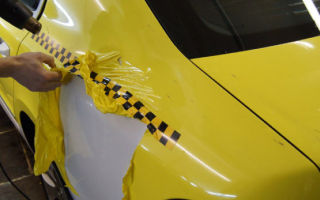How often should you change spark plugs and the main signs that they need to be replaced?
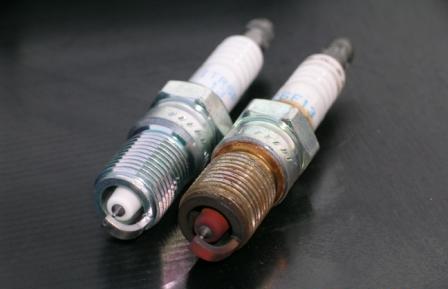
Many parameters of gasoline engines depend on the correct operation of spark plugs.
Monitoring their serviceability and timely replacement is a condition for proper operation of the vehicle.
Reasons for their natural and premature wear
The spark plug operates under extremely extreme conditions:
- high temperature in the working cylinder;
- aggressive environment in the form of a mixture of fuel, air and oil;
- high pressure during ignition;
- high voltage and temperature of electric spark.
The simultaneous action of these factors leads to an intensification of the processes of their natural wear. This process can be significantly accelerated in the following cases:
- reduction of compression, wear of valve stem seals due to oil entering the working volume;
- incorrect setting of the ignition angle, leading to the formation of increased carbon deposits;
- choosing spark plugs that do not match the engine brand;
- misfire in cylinders;
- incorrect gasoline/air ratio due to malfunctions of the flow meter, lambda probe, or air leaks;
- incorrect operation of injectors.
Signs that they need to be replaced
The main sign of the need to replace spark plugs is misfires (tribling). This is not always due to problems with spark plugs. To finally decide on the need to replace them, the easiest way is to install a known good one instead of the problematic spark plug.
The easiest way to identify a possibly faulty spark plug is with the engine running. To do this, it is necessary to sequentially disconnect the high-voltage wires (or the connector of the individual ignition coil) from each of them. The non-working cylinder will be the one from which, when disconnected, the nature of the engine operation does not change.
Also signs of a required replacement of spark plugs are:
- visual malfunction (contamination, carbon deposits in the gap area, change in the normal gray color of carbon deposits, its wetting, mechanical chips on the insulator);
- unstable engine speed;
- increased smokiness of exhaust gases;
- engine detonation;
- message from the “CHECK ENGINE” warning lamp or on-board computer.
How often do you need to change spark plugs?
Each manufacturer indicates the period or mileage of trouble-free operation of spark plugs. This period is calculated for engines with a service life of no more than five years. If the car is equipped with an older engine, the service life (mileage) of the spark plugs is reduced.
There is no clear gradation of mileage and timing for replacing spark plugs. Experienced car enthusiasts consider it correct to carry out a technical inspection and replace them before the start of each autumn-winter season of operation. If the car is not used in the cold season, it is rational to check and replace them in the spring.
Video - when to change spark plugs and why it is important:
Based on the car's mileage, spark plugs should be replaced after 15 - 20 thousand kilometers. Iridium and platinum spark plugs can easily withstand mileage of 100,000 km or more, but this is also with a relatively new engine.
Internal combustion engines running on gas have an increased combustion temperature of the fuel-air mixture; their service life should be reduced by 20-30%. Another factor in a similar reduction in the replacement period for spark plugs is the use of low-quality gasoline.
Their extraordinary replacement is carried out after major and major emergency repairs, or after the car has been parked for a long time.
Replacement sequence
Despite its apparent simplicity, this operation should be taken responsibly. Replacement should be made as a complete set (!) . Partial replacement of one or two “lost” spark plugs is only possible for a short time.
Different gaps and types of spark plugs and their conditions lead to inevitable failure of ignition timing, increased detonation, and contribute to increased engine wear.
The selection of spark plugs should be made for the vehicle based on reference data. You shouldn’t rely on “these are the best” recommendations. It is better to purchase products only from trusted manufacturers.
As the main tool for replacing spark plugs, it is better to use a special long head with rubber inserts to grip the spark plug being removed. Before purchasing it, you should measure the diameter of the mounting hole.
The standard sizes of spark plug heads are 16 and 21. The length of the seating zone can be different, up to 180 millimeters in certain engine models. In some cases, you can use a spark plug tube, but keep in mind that its reliability is less. It’s even worse to use special keys from unknown manufacturers in beautiful packaging. They may break the first time you unscrew them.
Sequence of spark plug removal:
- remove the installed high-voltage wires, having previously noted or photographed the sequence of their installation;
- if the car has individual ignition coils or a coil block installed in the spark plug space, dismantle them (in V-shaped engines this process can be complicated by the need to dismantle part of the intake manifold and other engine elements);
- be sure to check the spark plug installation areas for the presence of foreign objects (when removing the spark plug, fragments of insulation and other objects may fall directly into the cylinder and cause big problems);
- securely install the spark plug wrench, apply medium force, and begin unscrewing;
- if the dismantling process is difficult, it is necessary to use special means for decoking the threaded connections, and do not try to apply excessive force;
- remove the spark plug (if the retaining rubber band has come off, you can do this using the tip of a high-voltage wire);
- It is better to install a plug or throw a clean rag on the vacated spark plug hole (there are many cases when, during the repair process, nuts, washers and other “surprises” get there, that is, into the cylinder).
Video - replacing spark plugs for Renault Logan and Largus (8 valves):
New ones are installed according to the following rules:
- first, use a clean rag to clean the installation area from oils and dirt (if this place is inaccessible for visual inspection, it is better not to do this: trying to remove contamination from above the threaded connection, you can redirect it to the thread);
- when installing new ones, you must once again check that the seating depth of the spark plug matches the old one;
- The initial direction of the spark plug into the seat is done carefully using a spark plug wrench; you should not “throw” the spark plug, this may change the gap;
- preliminary tightening should be done with a slight force; if movement is difficult, you need to unscrew and start tightening the spark plug again;
- the final “squeezing” of the spark plug is done with medium force (at service stations, a torque wrench is used for this; the tightening torque is set in the range from 15 to 35 Nm, depending on the thread diameter and type of fit);
- The last stage of installation of spark plugs is the installation of high-voltage wires.
Why change spark plugs if the old ones work?
Theoretically, they can last ten years or more, especially if they are cleaned periodically.
There is an opinion that spark plugs should be changed only when obvious signs of wear appear, or when repairs related to problems with ignition and the engine as a whole are carried out. However, old, although serviceable, spark plugs can negatively affect engine performance:
- changing the gap area affects the ignition timing;
- minor misfires lead to increased detonation and mechanical stress;
- dirty spark plugs can cause breakdown of the ignition coil, high-voltage wires, and slider resistor;
- Incorrectly functioning spark plugs affect the environmental characteristics of an internal combustion engine.
The most dangerous problem when replacing spark plugs infrequently is coking of the threaded connection area . This is fraught with the possibility of thread breakage and damage to the spark plug during dismantling. In turn, such a malfunction may lead to the need for major repairs, even replacement of the cylinder block.
Therefore, experienced car enthusiasts carry out preventive dismantling and installation before the next autumn-spring season of car operation. At the same time, you can (and should) make a visual inspection of them.
Serviceable and serviced spark plugs are one of the main factors in the stable operation of a gasoline engine.
Video - spark plug wear and when to change them:
May be of interest:
Source: http://voditeliauto.ru/poleznaya-informaciya/avtoustrojstva/svechi-zazhiganiya/cherez-skolko-menyat.html
…how do you know when it’s time to change your spark plugs?
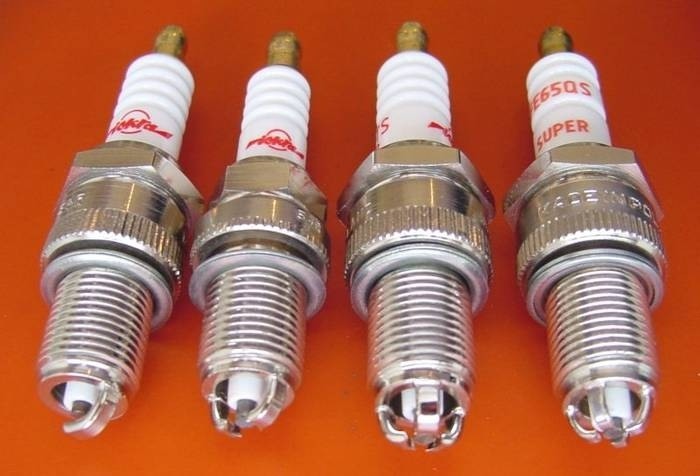
... I would like to know from the consultants who give answers in the automotive section - what are the signs to understand that it is time to change the spark plugs? What could be the impact of their untimely replacement? A. Zh.
Gefest V 8 auto parts sales specialist, answers the questions
— Their malfunction can damage the fuel system, and in this case you will have to spend much more on repairs. This is why it is important to know when to change spark plugs.
Signs of wear are sometimes very noticeable. If the car twitches while driving, the starter does not work immediately, and in order to start the car, several idle revolutions are required; if fuel consumption increases and engine dynamics decrease, it’s time to replace the spark plugs.
Determining the malfunction and the period after which to change the spark plugs is carried out in several ways. If the car does not start, or does not start immediately, it is worth determining what could be causing this.
The malfunction leads to a decrease in engine performance, if when the engine is turned on, an interval or gap appears in the cycle of uniform spark supply - not only its performance is reduced. The volume of evaporation during fuel combustion increases, raw fuel enters the gas exhaust system, which causes overheating and overload in the operation of the catalytic catalyst.
It goes without saying that this cannot but affect the condition of the entire system, and then it is necessary to change the spark plugs if it is determined that they are the cause of gaps or pauses.
Service life is determined in different ways, but it is best to replace it every 30 thousand kilometers.
Also, this indicator depends on the brand, and you can find out in more detail when you need to change spark plugs from the operating instructions.
The frequency of replacing spark plugs depends on when they were last changed. If the date cannot be determined, then their condition should be checked. By appearance you can find out how long it will take to change the spark plugs again.
Carbon deposits form during short journeys during which the engine does not warm up completely, especially in winter.
To clean the spark plug from carbon without removing it, I can recommend warming up the engine to operating temperature, this way the electrodes clean themselves.
The timing of replacing spark plugs depends on both the intensity of driving and the material from which they are made. There is one nuance here - 30 thousand kilometers are classified as classic options, while platinum and iridium spark plugs can withstand 90 thousand.
Another factor that determines when it is necessary to change spark plugs is the actual condition of the engine and the quality of gasoline poured into it.
The first sign that the ignition system is already old and will soon need to be replaced is the appearance of cracks on its ceramic part, that is, on the insulator. Another type of failure is the detachment of the insulator from the metal part.
It is best to remove the old kit all at once - thus preventing the possibility of similar complications in other components of the kit, even if they seem to be working.
Summarizing the opinions of experts, we can recommend adhering to the established period for replacing spark plugs. If for classics this is 15-20 thousand kilometers with active use of the car, then for platinum and iridium it is 100 thousand kilometers. This period does not depend on the appearance and condition, that is, if after its expiration everything looks quite serviceable, replacement must be carried out anyway.
Source: http://zerkalo-gazeta.com/kak-ponyat-chto-pora-menyat-svechi-zazhi/
How long does it take to change spark plugs?
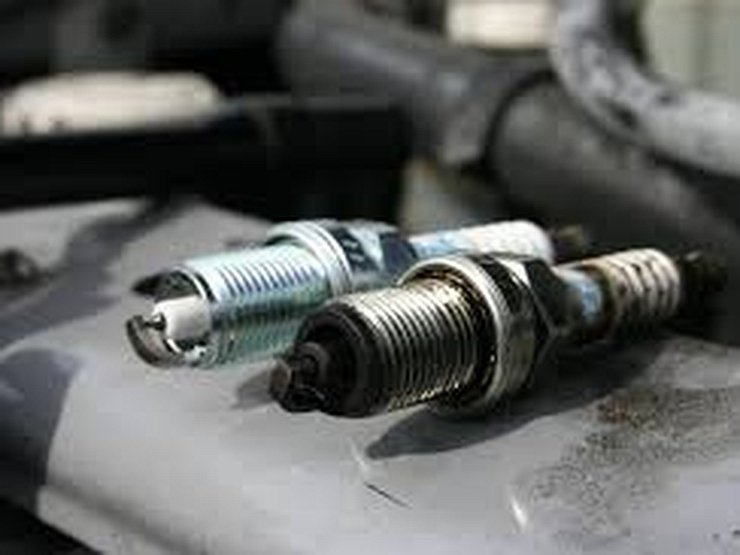
Spark plugs are quite an important part in the engine of any car. They are involved in the car's ignition system.
The design of modern spark plugs is quite durable, however, under high loads (which occur in the engine), they wear out, and low-quality fuel simply kills them (read a useful article - what are spark plugs and their main faults). After a certain period of time, it’s better for us to replace them, but after how long should we change them? Let's think...
Of course, if your car is under warranty, then you will change the spark plugs according to the regulations, for different manufacturers - it happens at different mileage. Usually this is from 30 to 80,000 kilometers.
Why such a run up? And here everything is simple - different manufacturers have different spark plugs, some have regular ones (they need to be changed more often), others have an iridium-coated core (these last longer), and there are also multi-electrode options.
But what if your car is already out of warranty? Then how long should it take to change spark plugs? After all, here you yourself must monitor their condition.
I traveled a lot to both official services and unofficial services that service cars. And you know, all the masters say one thing: the more often you change, the better!
Ideally this should be changed at every oil change! That is, after 15 - 20,000 kilometers! But if you use branded candles, then this pleasure is not cheap. So how long can they realistically work normally?
Guys, don’t delay replacing, no matter what quality spark plugs you have, even iridium or any other noble metals, it is recommended to change spark plugs no more than after 40 - 50,000 kilometers! Remember!
If you have cheap spark plugs, bought in large stores (for example, at AUCHAN), then we change these with every oil change. Preferably 10 – 15,000 kilometers. Such candles do not last long, and the core itself or its insulation is not always destroyed; it happens that the candle is broken in the place where the metal part is attached.
Here is a simple example in the photo, it didn’t even travel 12,000 kilometers, it was on a VAZ 2114.
The engine was running terribly, and the spark was leaving the top part, it was apparently affected by moisture, the spark plug was simply rusty. The entire set was replaced.
I had branded spark plugs on my FORD FUSION, after the engine started running unevenly, I just changed them. The mileage on this set was approximately 55,000 kilometers. After installing new ones, engine operation was restored.
That's all, change your spark plugs more often and your engine will run at 100%.
Rating:(9
Source: http://avto-blogger.ru/texchast/cherez-skolko-menyat-svechi-zazhiganiya.html
After how many kilometers should the spark plugs be changed?
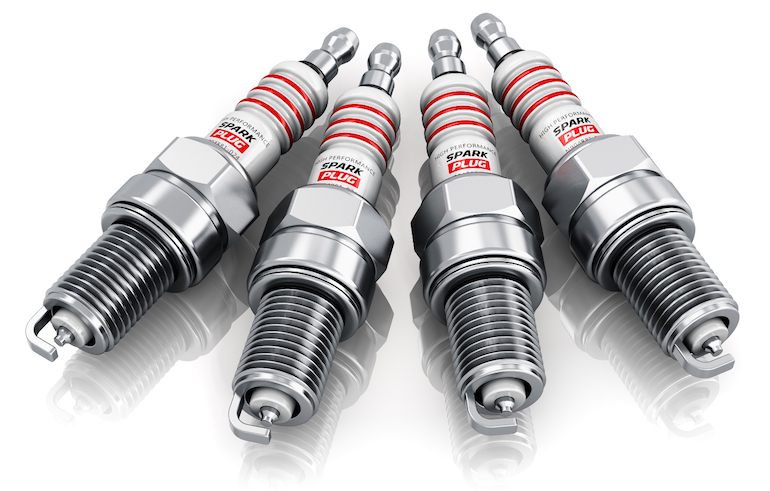
After how many kilometers should the spark plugs be changed?
- If the spark plugs have withstood fifteen thousand kilometers, then they can be left for another ten and changed after a run of 25 thousand kilometers. Rare candles can withstand 30 thousand, and if the 20 thousand mark is crossed, they will withstand another five. This means that we got very high quality candles.
- After how many kilometers you need to change the spark plugs depends on the degree of their clogging, and this, in turn, depends on how good and high-quality gasoline you use. It happens that even after 10,000 km the spark plugs fail, and in other cars after 20,000 km, the spark plugs are still nothing (they still suffer). Since the quality of gasoline and diesel fuel does not always depend on us, it is best to change the spark plugs after 10 - 15 thousand kilometers.
- After how many kilometers you need to change the spark plugs depends on several factors. It depends on what quality of fuel you use, and on what quality of spark plugs you have on your car. The spark plugs need to be changed when they become clogged.
- I change it when changing the oil. The money is not the biggest, but quot;swallowquot; It’s nice and she will definitely thank you for your care.
- it all depends on your car and the fuel you drive. but I would recommend changing it according to the manufacturer's recommendation. many people change spark plugs every 10,000 kilometers , because the quality of gasoline is not great, and spark plugs simply don’t last longer. but in general, if you don’t really mind the car, then you don’t have to change it as long as it’s driving
- The interval for replacing spark plugs depends on the quality of the spark plugs themselves, on the recommendations prescribed by the manufacturer and on the operating conditions of the vehicle. On average, normal spark plugs last for about 20-30 thousand kilometers, but given the quality of our fuel, it is recommended to change the spark plugs much earlier, after 10-15 thousand kilometers.
- Change it when they stop working, and it won’t take long to wait, since the quality of the spark plugs themselves is different and the quality of the fuel is not a gift, and from here the conclusion is very simple: the spark plugs work - good, but if they don’t work - replace them! That is life!
- I don’t change at all, I bought the car, I changed it right away, recently I unscrewed it, I adjusted the gap, I cleaned it, I put it back, that changing them works like a clock, you can buy a set in the trunk, start carrying it around, change it, and that’s it.
- This is most often indicated in the manufacturer's instructions for a particular car. On average it is 20 thousand km. However, the service life of spark plugs depends on the fuel the car runs on and on the design of the engine. When the engine is running on gas, the spark plugs need to be changed more often. This is approximately 12 to 15 thousand km.
Source: http://info-4all.ru/avto-i-moto/cherez-skolko-kilometrov-menyat-svechi-zazhiganiya/
When to change car spark plugs
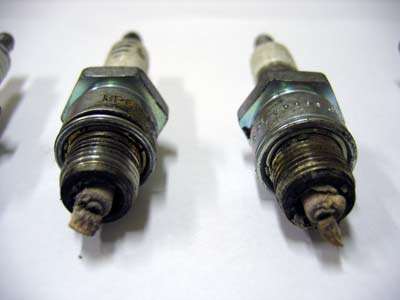
When to change spark plugs and how...
Greetings to all car enthusiasts, dear readers of the blog AAuhadullin.ru. It's time to find out how and when to change the spark plugs of a Renault Logan. At the time of replacement, my car had driven 41,932 km. Before this, they were replaced when the car had covered 21,000 km.
You can calculate the difference in mileage. This is easy to do, friends, you only need a calculator. From 41,932 km we subtract 21,000 km on the calculator and get 20,932 km, which is exactly how much the car drove after I changed the spark plugs for the first time.
In principle, the mileage figure is almost the same when compared with the first replacement of Renault spark plugs. Although the accompanying literature says when to change the spark plugs of a Renault car. It says that replacing spark plugs is recommended by the manufacturer every 15,000 km.
In principle, I try to stick to these numbers and drive from 15 to 20,000 km from replacement to replacement.
The figure from the Renault manufacturing plant coincides with the annotation for the spark plugs of the famous company BOSCH, which guarantees absolutely trouble-free operation of the spark plugs for 15 thousand km or 22 million sparks over this period. This means the original Bosch, and not all sorts of duplicates that exist in almost all countries of the world, even where it does not have its own representative office.
Before changing spark plugs, it is necessary, if possible, to blow out the surface of the engine with compressed air.
This procedure is done so that foreign objects cannot enter the combustion chambers when the spark plugs are unscrewed.
It is convenient to work with an X8 mm (8X10) socket wrench when unscrewing the ignition coils, from which the terminal blocks of the wires suitable for them were previously disconnected.
It is convenient to use a key to get to the base of the coil, where its mounting bolt is located. When changing, it is better to put the unscrewed fastening bolts in some container so as not to lose them. We are gradually handing over the fasteners for all four coils. The tightening force is small and you only need to use a wrench to break the bolt, and then it goes easily by hand.
Having given away the fasteners, we remove the coils one by one. BERU coils, look at the video to see what they look like. At the bottom of the coil there is a rubber cap that serves as a boot. The cap protects the spark plug well from dust, dirt and other foreign particles.
Now it’s summer, it’s warm and the coils come out with just a little hand effort, but in winter you have to put in more effort. In winter, the rubber “dumbs” and they can only be pulled out with the help of a wide nylon tape. In order to put the coils in their original places, we put them in order so as not to confuse them.
Removing spark plugs for a Renault Logan 16 cl...
To remove the spark plugs of a Renault Logan 16 cl, using a long spark plug wrench, we give and take out the old ones. We tear it out of place using a beard, making one or two turns and unscrewing it by hand.
Yes, I almost forgot to tell you Loganovods, a rubber insert must be installed in the spark plug wrench, which will hold it while removing it from the spark plug well.
For the 16 valve engine, spark plugs RENAULT (P) 77 00 500 155 Made in France are provided.
Such spark plugs are ideal for this type of engine, operating smoothly throughout the entire warranty declared mileage of 15-20 thousand km, showing moderate fuel consumption.
Useful advice…
If the spark plug “doesn’t work”, then you don’t need to make a lot of effort, as this can result in either thread failure or breakage of the part itself. In such cases, the candle must be turned out according to the back-and-forth principle, gradually turning out half the threads. Having unscrewed the “stuck” spark plug, it is best to go through the threaded part in the block head with a tap (14X 1.25) lubricated with graphite lubricant.
In the absence of a tap, it can be made from an old candle, from which the central insulator has previously been knocked out.
Then the threaded part of the part is cut crosswise with a hacksaw and the tap is ready for use. This improvised tap is screwed in using a spark plug wrench.
As he passes along the threads, he corrects the clogged threads, and the threads of the part can then be freely screwed into place.
It is clear from the old spark plug that it has already served its purpose honestly and has become a bit dark, although the electrodes are almost light brown, which indicates that the cylinder-piston group of the engine is in good condition. Although the old spark plugs traveled 21,000 km, with the required 15,000 km, they traveled an extra 6,000 km.
Installing spark plugs for a Renault Logan 16 cl...
Before installing new spark plugs, the threads can be lubricated with liquid graphite lubricant so that the threads do not stick and the part can always be easily unscrewed.
In the absence of graphite lubricant, the thread can simply be rubbed with a pencil lead, more conveniently marked “M” - soft.
We insert a new Renault spark plug into the rubber insert of the spark plug key and then insert it into the spark plug well of the engine block head and screw it in. At the same time, you should not rush, so as not to wrap it against the thread.
The spark plug wrench is long and you may not feel that the part has not “gone” the thread. Therefore, you need to wrap it carefully and by hand and only use a wrench at the end and do not overtighten it so as not to break the thread. In general, the clamping is performed until the sealing washer on the spark plug thread is slightly deformed so that it blocks the exit of gases from the combustion chamber of the cylinders.
Next, we perform a similar operation with the remaining spark plugs. In this case, you should pay attention to the electrodes of old spark plugs. On the second cylinder, the central electrode has a slight redness, which was not the case in the first cylinder. On the turned-out spark plug of the third cylinder, the red color of the central electrode is also clearly visible. On the last fourth there is also a red coating on the central electrode.
A red coating on the central electrode, reminiscent of the color of a brick, “indicates” that the engine is running on gasoline in which there is an excessive presence of additives containing metal.
Long-term operation of a car on such gasoline is not advisable, since such deposits with prolonged use of gasoline form a conductive coating on the surface of the insulators and the spark plug may eventually fail.
A red coating can also occur if the owner himself specifically added additional additives to the fuel.
After replacing the spark plugs, you can put the ignition coils one at a time in their places, according to the cylinders from which they were removed. The coils, as described above, were immediately laid out in order of removal 1.2.3 and 4.
We insert the coils until they make tight contact so that the sealing rubber “boot” “sits”.
When installing the ignition coils, we immediately orient their mounting hole along the hole in the block head to make it easier to install the mounting bolts.
Next, we tighten the coil mounting bolts, then use an X8 mm socket wrench to tighten them, again without fanaticism. We tighten the bolt until it stops and tighten it a little with a little force.
All that remains is to install the terminal connections to the ignition coils in order. We check everything again and you can start the engine to check.
On the old spark plugs of the Renault Logan, the fuel consumption according to the on-board computer was 8.7 litres/100 km.
Now we need some time to decide on the consumption of completely new spark plugs, as well as old ones with a mileage of 20,932 km. To do this, you need to drive about 200-300 km and compare the consumption readings on the dashboard. Then it will be possible to draw a specific conclusion - whether the new spark plugs save money or not, and we will also find out how the old ones saved gasoline.
After the next replacement, you will need to check the color of the spark plug insulator after driving on a different gasoline.
Watch the YouTube video:
Do you Loganovods change the spark plugs of your car?
You can also read other articles:
Engine oil change success
When to change spark plugs
How to choose an engine oil filter
Why did the car stall?
You can download the program for elm327 here
Source: https://www.aauhadullin.ru/2014/09/kogda-menyat-svechi-zazhiganiya/
Step-by-step instructions on how to replace spark plugs and how long after this should be done
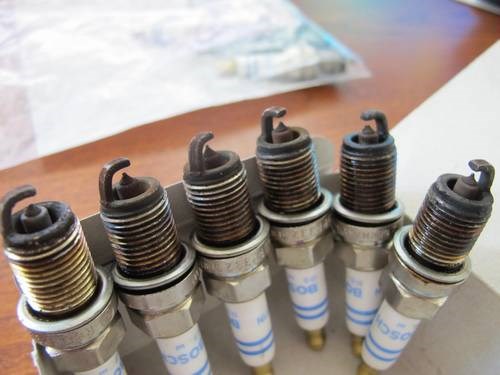
For stable and trouble-free operation of the car, it is necessary to frequently carry out timely maintenance, including high-voltage spark plugs. The frequency of checking clearances is determined by the car manufacturer.
On average, if there are no malfunctions and the operating rules are followed, spark plugs should be replaced every 25–30 thousand km.
In cars that use gas as the main fuel, the replacement period is reduced by 25–35%. Spark plug gaps must be checked every 6 thousand kilometers.
The World Matizov channel presents the frequency of replacement of spark plugs for gasoline cars.
Characteristic signs of faulty spark plugs
Signs of faulty spark plugs are:
- unstable operation of the engine, the engine troits and is difficult to start;
- the power of the unit has dropped significantly;
- the consumption of the fuel-air mixture has increased;
- the color of the exhaust gases has changed;
- failure of the cylinder-piston group.
Reasons for the formation of black soot
Black carbon deposits on spark plugs appear due to a malfunction of the engine or ignition system.
The reason for this process may be:
- The thermal clearances of the valve mechanism are set incorrectly or the valve in the motor head is burnt out. Carbon deposits form on one side of the electrode.
- Incorrect candle selected. The potassium number depends on the heating of the engine. The higher this indicator, the higher the engine temperature. With a low value, the spark plug burns out on the electrode cone.
- If the spark plug is completely blackened, the cause is a rich fuel mixture.
- Light carbon deposits indicate a clogged air filter.
- Black glow occurs when the ignition angle is incorrect.
These problems can be diagnosed by the condition of the ignition elements.
Why is it so important to observe replacement intervals?
If the car owner is overdue for replacing the spark plugs, this will not immediately lead to serious malfunctions. But a situation may occur when the car will not start. To avoid such a problem, it is important to observe the frequency of changing elements.
How to check spark plugs
You can understand that it’s time to change the ignition elements not only by the behavior of the car in motion, but also with the help of devices such as a multimeter and a gun.
MultimeterPistol device
Diagnostics with a multimeter
This device checks for breakdown of the central electrode of the spark plug. You need to turn on the ohmmeter mode. One wire is connected to the spark plug output, and the other to the thread. If the value on the dial is less than 100 Ohms, then the element is broken and requires replacement. This method is indirect, since the candle is checked only for breakdown.
Candle gun
To check the condition, insert the candle into the groove and put on a leash. By pressing the trigger of the gun, a spark should appear and the signal light should light up; if everything corresponds, the element is working. When the spark plug does not work in the appropriate manner, it must be replaced. You need to replace the ignition elements as a set.
Procedure for replacing spark plugs
When the deadline has come or a technical malfunction has occurred with the spark plugs, we change the elements as follows:
- The hood opens, the battery and high-voltage wires on the spark plugs are disconnected. It is necessary to remember and mark the locations of the conductors along the cylinders. On some cars with a 16-valve engine, access to the spark plugs is blocked by the manifold. It must be removed before replacing the ignition elements.
- Places where spark plugs are installed are cleaned of dust and dirt using a metal brush. Next, you need to thoroughly blow air over the parts so that debris does not get into the cylinder.
- The old spark plugs are removed using a 18 or 21 wrench head and their technical condition is inspected.
- If there is no black carbon deposits, then you can safely install new spark plugs. Before installation, you need to check the gap between the electrodes, it should be the same. The gap parameter is individual for each car, but on average it is 0.75-1.2 mm.
- The candles are being drawn. When tightening, do not use long levers so as not to strip the threads in the engine.
- The armored wires are being connected.
- The terminal is put on the battery and the engine starts. The engine should start smoothly.
- You need to drive 1 kilometer and inspect the spark plugs for carbon deposits.
Precautions when replacing spark plugs
When replacing spark plugs in a car, work must be done with a cool engine to avoid burns. You need to wait two to three hours until the engine cools down.
Video “Replacing spark plugs”
The video from the Mir Matizov channel shows how to replace spark plugs on cars.
Source: http://AvtoZam.com/elektronika/pusk/zamena-svechej/
After how long to change spark plugs
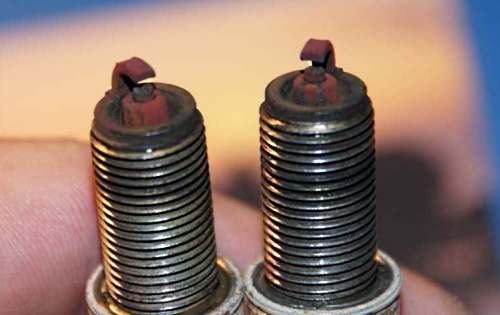
How long spark plugs
Spark plugs are quite an important part in the engine of any car. They are involved in the car's ignition system.
The design of modern spark plugs is quite durable, however, under high loads (which occur in the engine), they wear out, and low-quality fuel simply kills them (read the useful article on what spark plugs are and their main faults). After a certain period of time, it’s better for us to replace them, but after how long should we change them? Let's think
Of course, if your car is under warranty, then you will change the spark plugs according to the regulations; different manufacturers do it at different mileage. Usually this is from 30 to 80,000 kilometers.
Why such a run up? And here everything is simple - different manufacturers have different spark plugs, some have regular ones (they need to be changed more often), others have an iridium-coated core (these last longer), and there are also multi-electrode options.
But what if your car is already out of warranty? Then how long should it take to change spark plugs? After all, here you yourself must monitor their condition.
I traveled a lot to both official services and unofficial services that service cars. And you know, all the masters say one thing: the more often you change , the better!
When to change spark plugs? Why is it important?
Replacing spark plugs is necessary every 25 thousand km. mileage, even if they give a spark and look quite working....
FOR BEGINNERS! Wear of spark plugs (mileage 60,000)
I talk in detail about the wear of spark plugs , namely after a run of 60,000 kilometers, and why they are needed...
Ideally this should be changed at every oil change! That is, after 15 - 20,000 kilometers! But if you use branded candles, then this pleasure is not cheap. So how long can they really work normally?
Guys, don’t delay replacing, no matter what quality spark plugs you have, even iridium or any other noble metals, it is recommended to change spark plugs no more than after 40 - 50,000 kilometers! Remember!
If you have cheap spark plugs, bought in large stores (for example, at AUCHAN), then we change these with every oil change. Preferably 10 – 15,000 kilometers. Such candles do not last long, and the core itself or its insulation is not always destroyed; it happens that the candle is broken in the place where the metal part is attached.
Here is a simple example in the photo, it didn’t even travel 12,000 kilometers, it was on a VAZ 2114.
The engine was running terribly, and the spark was leaving the top part, it was apparently affected by moisture, the spark plug was simply rusty. The entire set was replaced.
I had branded spark plugs on my FORD FUSION, after the engine started running unevenly, I just changed them. The mileage on this set was approximately 55,000 kilometers. After installing new ones, engine performance was restored.
That's all, change your spark plugs more often and your engine will run at 100%.
Source: http://5net.ru/cherez-skolko-menjat-svechi-zazhiganija/
How often should you change spark plugs in a car?
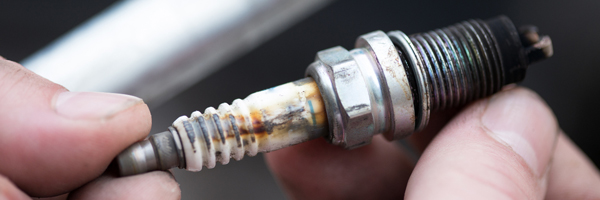
Is the engine difficult to start? Even at idle speed the engine cannot be called smooth? The problem can be hidden in anything, but the first thing a car owner needs to check is the degree of wear of the spark plugs.
But an experienced car owner will never allow such a situation to happen and will replace the spark plugs in time.
And if you don’t have enough experience, we will tell you in detail about how often you need to change spark plugs in a car, and what their wear can lead to.
How long is the service life of car engine spark plugs?
Often, experts set a period of 35-45 thousand kilometers. However, in each case this period will be different, since all candles are different from each other. High-quality ones, made by a reliable manufacturer from durable materials, will last many times longer than cheap counterfeit ones.
Therefore, every time you install new spark plugs, be sure to check what is written on the package of the kit, and at least partially rely on the deadlines indicated on it.
Important! If classic spark plugs made of steel can last on average only about 35 thousand kilometers, then those made of platinum or iridium can last two or even three times longer - up to 90 thousand kilometers. Accordingly, the price of such spark plugs will differ significantly, so it is rational to install them only on expensive cars.
But the service life of the spark plugs cannot tell you how many kilometers to change the spark plugs. After all, the answer to this question largely depends on the wear and tear of the engine and other systems, driving style, type of fuel and even the quality of the engine oil. When it is necessary to change the spark plugs in a car, we will tell you further.
How often should you change spark plugs: the opinion of experts and car enthusiasts
So after how many kilometers do you need to change spark plugs? This depends on a huge number of factors that are important to consider in each individual case. It is also worth understanding that if you and your friend bought the same spark plugs at the same time and installed them in their cars, you may need to replace them at different times. It all depends on:
• Mileage. The more you drive your car, the more the spark plugs will wear out. According to this criterion, manufacturers and experts call for replacement every 35-45 thousand km.
• Driving style. Operating spark plugs at very high speeds and under high temperatures reduces their quality and makes them more vulnerable. So on high-speed cars, experts advise replacing them every 20, or even 15 thousand kilometers.
• Quality of fuel and lubricants. If you use low-quality fuel, it will leave a lot of soot on all engine parts, including spark plugs. Soot and excess deposits impair the performance of spark plugs and may necessitate their replacement after only 10 thousand kilometers.
• Serviceability of the engine and its main systems. If the engine is not running properly - too much fuel is supplied to the combustion chamber, this will lead to excessively intense work of the spark plugs and the formation of a large amount of soot. If you want to extend the life of your spark plugs, take care of your engine's health.
• Make and age of the car. Each car functions differently, starts the engine differently, and uses different fuels. It is clear that on old “domestic” cars, spark plugs will have to be replaced more often than on new “foreign” cars. More often, the need for this procedure will arise when we are talking about sports cars.
• The material from which the candles are made. We have already talked about this above - the higher quality and more reliable the alloys from which the spark plugs are made, the less often they will have to be changed. In this regard, even when purchasing, you should splurge on high-quality products that will confidently provide you with reliable and long-term operation.
• External operating conditions. We are talking about the time of year in which the car and its spark plugs are operated.
It is worth understanding that in winter many more factors can lead to wear and tear than in summer, since the car engine is constantly either cooled to very low temperatures or warmed up during operation.
Frequent temperature changes within 100˚C can damage not only the spark plugs, but also the engine itself.
All of these were mostly expert statements. But what do ordinary car enthusiasts think about the timing of replacement of spark plugs? Ordinary people agree that to determine this time, you need to carefully monitor the operation of your engine, and even at the first signs of wear on the spark plugs, change them immediately. What these signs are, we will study further.
How to determine when it's time to change spark plugs: studying the signs of wear
You can understand when it is necessary to change the spark plugs, first of all, by their condition.
Signs of faulty and worn spark plugs are as follows:
• Car engine operation. This is the surest sign of wear on the spark plugs, until which, however, you should not delay replacing them. After all, if the car starts to twitch while driving, gives a false start, increases fuel consumption and reduces the dynamics of the engine - these are no longer signs of the need for replacement, but undesirable consequences of overdue replacement of spark plugs.
• Increased fuel consumption. A thrifty car owner always knows how much his car “eats” over a certain period of mileage. If this indicator begins to increase, it means that the spark plugs are worn out and should be replaced.
• Exhaust gas quality. When the pipe literally smokes, it only means that the engine is not working properly. The first thing to do to fix the problem is to visually assess the condition of its spark plugs and replace them.
Important! In cases where fuel consumption increases and vehicle exhaust gases become black, the cause may not always be spark plugs.
Therefore, it is important to try the replacement and evaluate how it affected the situation.
If the engine works the same with new spark plugs, the reason must be looked for elsewhere, and you can return the old plugs back to the engine - let them finish their work.
• Appearance of spark plugs. If the spark plugs are darkened, covered with soot, or have other damage, they cannot fully perform the tasks assigned to them and require immediate replacement.
Do I need to change spark plugs, and what will happen if this is not done in a timely manner?
Spark plugs are no joke, as their faulty operation will not only deteriorate the performance of the car, but can also damage the engine itself. The most tragic consequence of untimely replacement of spark plugs can be detonation of the fuel-air mixture in the combustion chamber of a car engine.
Although in an isolated case this will not cause damage to the engine, frequent cases of detonation can even cause burnout of the piston edges, cylinder head gaskets, and spark plug electrodes may fail. In this case, the spark plugs themselves may stop producing a spark altogether, so it will be impossible to start the car at all.
All this only speaks in favor of the fact that it is not only necessary to change spark plugs, but it must be done in a timely manner. It is clear that this causes additional costs, which every car owner tries in every possible way to avoid.
But it’s definitely not worth saving on a car that you’re driving yourself, as greed can lead to an accident.
In this case, it is better to ensure that the service life of the car's spark plugs is as long as possible.
Proper care of spark plugs is the way to increase the replacement period of spark plugs
Although the need to replace spark plugs will come no matter how much attention you pay to them, you can still extend their life with a few simple tips:
1. Do not put anything on the car engine. This applies not only to the quality of products, which you need to pay attention to first. We are also talking about recommendations regarding spark plugs, which are given by the car manufacturer himself. In this matter, it is important to pay attention even to such a characteristic as the heat number.
2. Look under the hood as often as possible and check the condition of the spark plugs. Do not forget that even appearance is an important criterion for their work.
3. If you want to increase the service life of spark plugs, install iridium or platinum spark plugs on the engine of your “iron horse”.
4. Use only high-quality fuel, the combustion of which will not lead to the formation of soot on the surface of the spark plugs and other engine parts.
5. Regularly change not only candles, but also filters. This applies to fuel filters, air filters, and oil filters.
6. Pay attention to the correct installation of candles. If the gap is too small, problems with starting the engine may occur. At the same time, driving with incorrectly installed spark plugs will also lead to their premature wear.
But still, the main rule for caring for spark plugs is their timely replacement. We hope our article helped you find out the answer to the question of when is it time to change spark plugs and why it should be done on time.
Source: http://autoprivat.ru/remont_avto/kak_chasto_nado_menyat_svechi_v_avtomobile.html


